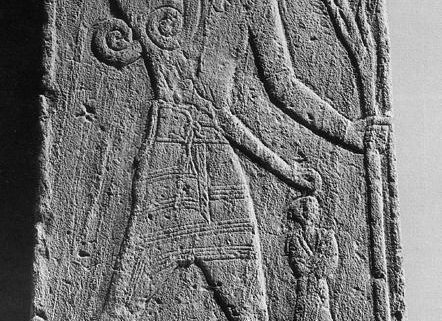Baal (properly spelled Baʿal) was the main enemy of Yahweh in the Old Testament. One could argue that he was even more of a villain in the Bible than Satan, who’s only mentioned in fourteen Old Testament verses, in the books of 1 Chronicles, Job, and Zechariah. Baal, on the other hand, appears 106 times in 88 verses (including personal and place names, like Baal-zephon).
Baal is first mentioned in the Bible in Exodus and he was still around 3,400 years later in the New Testament. Jesus discussed him with the Pharisees (see Matthew 12:22-28; Beelzebul means “Baal the prince”).

Stela at the Louvre from the ancient city of Ugarit depicting Baal in characteristic “smiting” pose, holding mace and thunderbolt
Baal isn’t a name, it’s a title. It means “lord,” in the same way we Christians usually say Lord (and our Bibles read Lord) instead of saying Yahweh or spelling out YHWH. It’s rather arrogant, when you think about it. And Baal wasn’t the only one; over time, Babylon’s chief god Marduk came to be known as Bel, which likewise means “lord.”
Baal has had a long career. He’s not recognized as an active deity in our world today, at least not by the secular scholars who have researched the people who worshiped him. It’s safe to say most American Christians think of Baal as a sort of cosmic imaginary friend of the pagan nations around ancient Israel—but surveys show that most American Christians don’t believe in Satan or the Holy Spirit, either.
There may be a few neopagans here and there trying to recreate the old religion of the ancient Canaanites, but like aging pop divas, the old gods reinvented themselves as time and people moved on. We’ve already seen how Sumerian Inanna became Babylon’s Ishtar, the Semitic Astarte, Aphrodite of Greece, and Venus of Rome. Today, the old gods condemned by Yahweh in Psalm 82, Isaiah 24:21-23, and elsewhere, are viewed as characters in ancient literature, if they’re considered at all.
Over time, Baal replaced the original name of the West Semitic storm-god Hadad (or Haddu), who was also called Adad/Addu by the Akkadians. Baal has also been identified with the Hurrian god Teššub, the Hittite god Tarhunt, the Urartian god Teisheba, the Sumerian god Iškur, the Amorite god Amurru (incorrectly, as it happens), and others.
Of course, Baal is best known as Zeus to the Greeks and Jupiter to the Romans.
The earliest of these storm-god manifestations was Iškur (note: the š sounds like “sh”). However, Iškur was a minor deity in the Sumerian pantheon. That’s logical; in a land that’s mostly desert, a god of storms and life-bringing rain wasn’t as important as Enki, who controlled the fresh waters of the Tigris and Euphrates. Irrigation was far more important than rainfall for growing crops in southern Mesopotamia. Farther north, where rain was key to agriculture, Iškur played a larger role in the pantheon.
The chief god Enlil and his son, the war-god Ninurta, also had storm-god characteristics. This left Iškur looking like a pale imitation of the others, a third-tier superhero in a comic book universe. He was believed to be the son of Anu, although some traditions claimed that Enlil was his father. This could mean that Iškur wasn’t a native Sumerian deity but an import from Sumer’s Semitic-speaking neighbors. As the patron god of Karkara, a minor city near Uruk in southern Mesopotamia, Iškur’s cult center didn’t have enough political clout to elevate him into the upper rank of the pantheon, as Babylon later did for Marduk.
The first written evidence of the cult of Iškur comes from the cities Lagash and Adab in the middle of the 3rd millennium BC Adab was near Karkara, site of Iškur’s temple, the House of the Big Storms. Unfortunately, the ruins of Karkara haven’t been discovered yet, so we don’t know much about the cult of Iškur or local traditions about him. But based on prayers and rituals that have been preserved, it appears Iškur, like most of the Mesopotamian gods and goddesses, could be good or bad depending on his mood. The storm-god brought necessary rain for the crops needed to survive but he could also destroy fields with wind, hail, and flood.
He first appeared under the name Hadda at Ebla around 2500 BC, and as Adad in Old Akkadian texts, the period of history that began with the empire of Sargon the Great around 2330 BC We know they’re the same because the Sumerian logogram for Hadda/Adad was the same used for Iškur (dIM). As god of the heavenly waters, Iškur was sometimes praised as the twin brother of Enki. This may be an early example of the “twin gods” motif in ancient mythology. Sometimes they’re brother-sister twins, such as Apollo and Artemis; sometimes divine-mortal twins, like Castor and Pollux; and sometimes, as in this case, a pair of brothers, one more important than the other, at least in the early days. Until the early 2nd millennium BC, it wouldn’t have been a compliment for Enki, the god responsible for the fresh water of the abzu and the fundamental laws of civilization, the mes, to be compared with a minor deity like Iškur.
Iškur-Adad, later Baal, played a key role in the cosmology of Mesopotamia for the next 2,500 years. His importance to the cultures of the region grew with the political influence of the Amorites, who may have introduced Iškur into Sumer, reaching its peak in the 2nd millennium BC and lasting through the time of Jesus.
At Mari, which was on the Euphrates about 75 miles southeast of the modern city of Deir ez-Zor, a powerful but short-lived Amorite kingdom grew from the ashes of an older state that had been smashed by Sargon the Great. The name Haddu often appears in texts found at Mari alongside Dagan, a grain god (contrary to common belief, Dagan/Dagon was never a fish god), and Itūr-Mēr, the patron god of the city of Mari, as one of the three great gods of the kingdom.
As political control of Mesopotamia shifted from Akkad to Ur and then to Babylon between 2150 BC and 1900 BC, powerful Amorite kingdoms in Assyria, Mari, and Yamḥad (modern Aleppo, Syria) emerged alongside the old Babylonian empire. At the same time, the storm-god’s identity gradually shifted from Sumerian Iškur to Akkadian Adad and his importance in the pantheon grew.
By the time Hammurabi brought Babylon to the greatest extent of its power, around 1750 BC, Adad—Baal—was firmly established among the great gods of Mesopotamia.

Derek Gilbert Bio
Derek P. Gilbert hosts SkyWatchTV, a Christian television program that airs on several national networks, the long-running interview podcast A View from the Bunker, and co-hosts SciFriday, a weekly television program that analyzes science news with his wife, author Sharon K. Gilbert.
Before joining SkyWatchTV in 2015, his secular broadcasting career spanned more than 25 years with stops at radio stations in Philadelphia, Saint Louis, Little Rock, and suburban Chicago.
Derek is a Christian, a husband and a father. He’s been a regular speaker at Bible prophecy conferences in recent years. Derek’s most recent book is The Great Inception: Satan’s PSYOPs from Eden to Armageddon. He has also published the novels The God Conspiracy and Iron Dragons, and he’s a contributing author to the nonfiction anthologies God’s Ghostbusters, Blood on the Altar, I Predict: What 12 Global Experts Believe You Will See by 2025, and When Once We Were a Nation.




Leave a Reply
Want to join the discussion?Feel free to contribute!